From reader Paul in Bismarck: “How do you deal with the requirement for a 4 foot frost wall on buildings that will have plumbing installed in them. Typically, the concrete footing on a stick built structures qualifies as the frost wall. How is this accomplished with a pole building that will be used as a residence?”
Mike the Pole Barn Guru writes:
I would look towards a variant of the Frost Protected Shallow Foundation (FPSF) system as a solution.
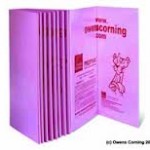 Set the columns in the ground so the base of the column is at or below frost depth. Backfill the bottom portion of the hole with premix concrete, making sure to not have the concrete more than 24 inches above grade. You will have to dig a trench along the outside of the columns all the way around the building. The trench will need to be approximately 24 inches deep and the width will vary depending upon the location along the building perimeter (it will have to be wider at the corners). After the skirt boards/splash planks are installed, place a 24 inch tall minimum R-12 expanded or extruded polystyrene insulation board on the inside of the skirt board, with the top edge four inches up from the bottom of the skirt board.
Set the columns in the ground so the base of the column is at or below frost depth. Backfill the bottom portion of the hole with premix concrete, making sure to not have the concrete more than 24 inches above grade. You will have to dig a trench along the outside of the columns all the way around the building. The trench will need to be approximately 24 inches deep and the width will vary depending upon the location along the building perimeter (it will have to be wider at the corners). After the skirt boards/splash planks are installed, place a 24 inch tall minimum R-12 expanded or extruded polystyrene insulation board on the inside of the skirt board, with the top edge four inches up from the bottom of the skirt board.
Extruded polystyrene insulation will be placed horizontally outward (in the trench) from the vertical insulation. In your climate, probably a minimum of R-12 along the walls and R-15 at the corners. The corner area will extend at least 80 inches along the walls from each corner and out 48 inches. The balance of the walls will be out 36 inches.
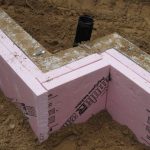 Now the difference between “typical” FPSF and the post frame version – instead of pouring a thickened slab, backfill on the heated side of the vertical insulation with clean sand, then just pour a slab on grade inside the building. There is no “magic” to the insulating value of concrete, so I see no reason to throw concrete into making the edge of the slab thicker when it is merely being used as backfill and supports no downward weight.
Now the difference between “typical” FPSF and the post frame version – instead of pouring a thickened slab, backfill on the heated side of the vertical insulation with clean sand, then just pour a slab on grade inside the building. There is no “magic” to the insulating value of concrete, so I see no reason to throw concrete into making the edge of the slab thicker when it is merely being used as backfill and supports no downward weight.
Areas without the extreme cold winters Bismarck has could get by with lesser amounts of insulation.
Download a free copy of The Revised Builders Guide to Frost Protected Shallow Foundations here: https://www.scribd.com/document/341135783/Revised-Builder-s-Guide-pdf
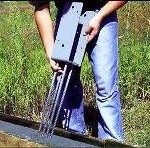 Now we do have a fair number of clients using wet set brackets, keeping their building columns above ground (
Now we do have a fair number of clients using wet set brackets, keeping their building columns above ground (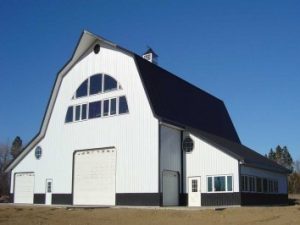 In many cases it may be possible for an engineered truss repair to be made, to upgrade load carrying capacity of truss bottom chords to a minimum of five psf. I’m sorry to say, this is not free. Truss company’s engineer will need to put his or her license on the line in designing a “fix” for trusses designed for a load other than is now intended. It’s not same as designing original trusses. If you think about it, redesigning and augmenting something you have built, is always more time consuming (and brain challenging!) than first time around. His time and expertise are not without a charge. It’s not usually “much”, like a couple hundred dollars. Then there is cost of materials to do repairs. This will be final out-of-pocket expense if you are doing truss repairs yourself. If not, a contractor’s charge must be added. All totaled, it could run you anywhere from a couple hundred dollars to over a thousand or more.
In many cases it may be possible for an engineered truss repair to be made, to upgrade load carrying capacity of truss bottom chords to a minimum of five psf. I’m sorry to say, this is not free. Truss company’s engineer will need to put his or her license on the line in designing a “fix” for trusses designed for a load other than is now intended. It’s not same as designing original trusses. If you think about it, redesigning and augmenting something you have built, is always more time consuming (and brain challenging!) than first time around. His time and expertise are not without a charge. It’s not usually “much”, like a couple hundred dollars. Then there is cost of materials to do repairs. This will be final out-of-pocket expense if you are doing truss repairs yourself. If not, a contractor’s charge must be added. All totaled, it could run you anywhere from a couple hundred dollars to over a thousand or more.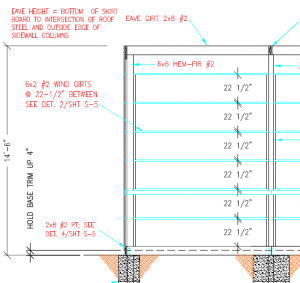 First, a question is hiding a building exterior pressure preservative treated skirt board (aka splash plank). Simple answer is yes, building is already designed so this can be done. Skirt board should be placed per engineer sealed building plans, showing drip edged base trim bottom four inches above grade. This allows for a nominal four inch thick (finished thickness 3-1/2”) sidewalk, driveway, landing or other concreted areas to be poured against exterior of splash plank, coming in ½ inch below bottom of drip edge. Any such pours should be along a grade sloping sufficiently away from building a minimum slope of 2%, to keep water from pooling against building.
First, a question is hiding a building exterior pressure preservative treated skirt board (aka splash plank). Simple answer is yes, building is already designed so this can be done. Skirt board should be placed per engineer sealed building plans, showing drip edged base trim bottom four inches above grade. This allows for a nominal four inch thick (finished thickness 3-1/2”) sidewalk, driveway, landing or other concreted areas to be poured against exterior of splash plank, coming in ½ inch below bottom of drip edge. Any such pours should be along a grade sloping sufficiently away from building a minimum slope of 2%, to keep water from pooling against building.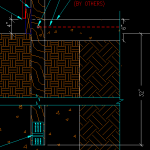 DEAR ERIC: I’d do a Frost Protected Shallow Foundation using embedded columns with a concrete footing below and a bottom collar which would be 24 inches or more below grade. I’d backfill the inside of the vertical insulation with sand and pour a slab on grade. Read more here:
DEAR ERIC: I’d do a Frost Protected Shallow Foundation using embedded columns with a concrete footing below and a bottom collar which would be 24 inches or more below grade. I’d backfill the inside of the vertical insulation with sand and pour a slab on grade. Read more here: 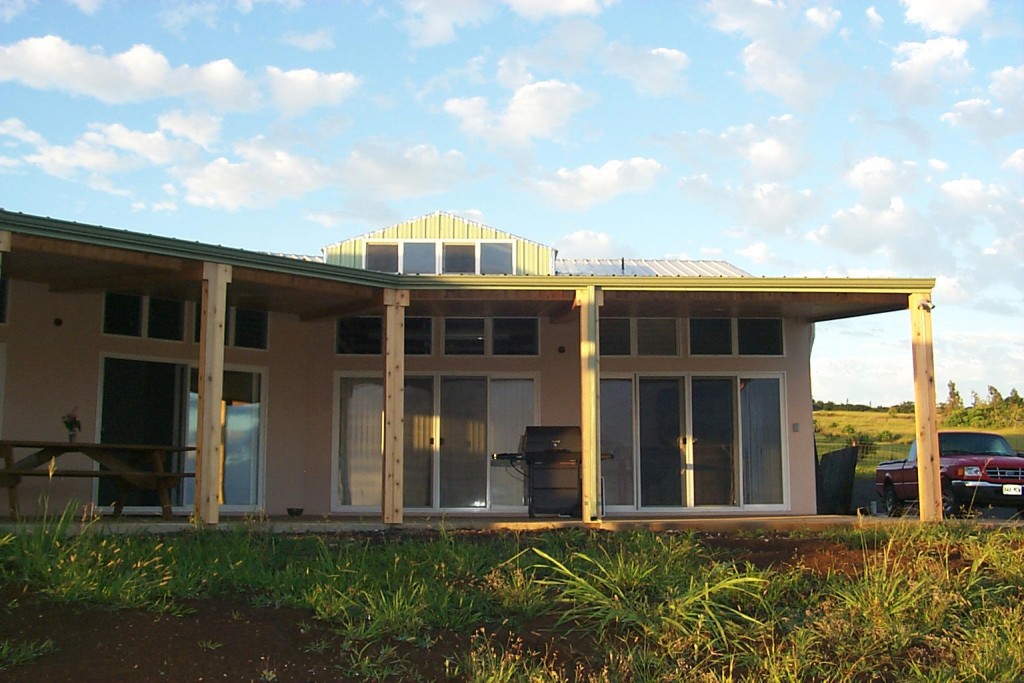 DEAR MARC: We’ve provided many post frame building kits to the Hawaiian Islands and our system is set up so all pressure preservative treated lumber is automatically selected for buildings going to Hawaii. Generally buildings for Hawaii are shipped in containers from the Port of Seattle, as shipping costs are lower than obtaining the components on the islands.
DEAR MARC: We’ve provided many post frame building kits to the Hawaiian Islands and our system is set up so all pressure preservative treated lumber is automatically selected for buildings going to Hawaii. Generally buildings for Hawaii are shipped in containers from the Port of Seattle, as shipping costs are lower than obtaining the components on the islands.





